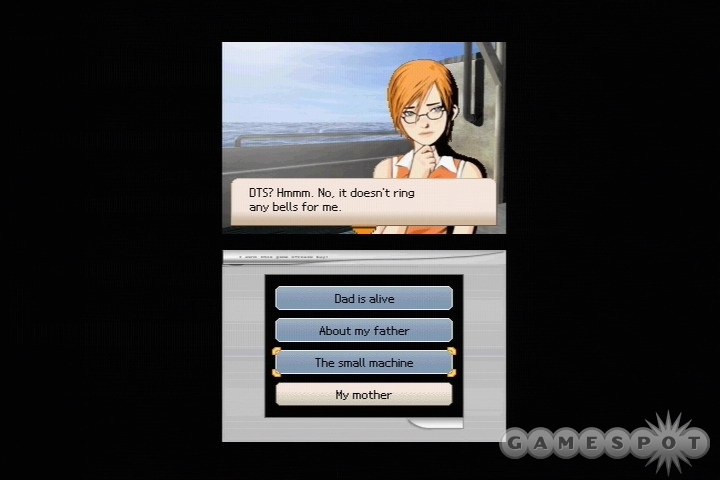Adventure games of any sort seem few and far between these days, and handheld adventures are a rare beast indeed. Trace Memory distinguishes itself not only through its genre, but by cunningly utilizing the myriad features of the Nintendo DS to create, at its best moments, a uniquely involving experience. These moments are all too fleeting in a game that has a very short lifespan, and while there's a nice little story and some flashes of brilliance in the design, it's all over far too soon.

The events in Trace Memory revolve around one Ashley Mizuki Robbins, age thirteen, who on the eve of her fourteenth birthday boards a ferry for the ominously named Blood Edward Island. After believing her whole life that her parents are dead, she receives a package in the mail with an electronic device and a note from her father, summoning her for a meeting. The machine is a Dual Trace System (you discover exactly what that means later on) or DTS, and it's attuned specifically to Ashley and no one else. What the device does, its relation to her parents' research into memory, and the truth about what happened to her father are only part of her journey. When she arrives on the island, she encounters "D," the ghost of a young man with a strange rune on his chest and no memories of his previous life. The two become companions for an adventure that leads them not only into the depths of the sprawling Edward mansion, but also into the clouded past of their own memories. The story does a good job of keeping things engrossing, with plenty of little tidbits for you to discover about Ashley and D, and matters are helped along by the gameplay.
You'll move Ashley around on the bottom screen of the DS using either the D pad or the stylus, and as you wander around the simple 3D environments, static and more detailed views will appear on the top screen in 2D. When you're near an area that you can examine more closely, an icon will light up that you can tap, and then the top screen view will move to the bottom, where you can investigate every cranny or talk to a character that happens to be nearby. This type of investigation is necessary to find clues to help you to progress, but the game is good about giving you subtle and not-so-subtle hints via text and imagery that let you know when you should examine something more closely. There are puzzles of various sorts to solve, of course, and the puzzles are what make the game special.
There are all kinds of simple actions that you would expect a DS game to utilize--some areas require you to move items around with the stylus, to interact with objects, or to rub the touch screen to clear off a surface. But there are also a few places that require the microphone, and a few truly testing instances that use the dual screens in ways that might not occur to you naturally. In fact, it's hard to say whether these puzzles are a flash of genius or simply infuriating, but once you've figured them out, it's both gratifying and a testament to the DS's inventiveness and design.
The main issues with Trace Memory are that these moments can easily be counted on both hands without going over, and that the game itself is over very quickly. You could burn through the entirety of Trace Memory in about four or five hours in a single marathon session. Aside from a couple of minor Easter eggs on a second play-through, the game offers nothing else to help flesh things out. There are a couple of endings that hinge on whether or not you're able to help D remember his past life and how he came to die, but if you needed to whirl through the game a second time to figure everything out, it'd take you far less time. And aside from the sometimes neat puzzles, the overall gameplay is pretty simple. It's a shame that the depth shown in some of the brain teasers isn't used more often, or that the title isn't meatier overall.
The 2D art in the game is where all the richness of detail is, with interesting environs to explore. Each section of the mansion and its grounds has its own feel, and you'll be happy to check each and every nook for hidden items and information. The information's not all messages like, "This drawer is locked," either--many of the items and areas have interesting descriptions that make checking them worthwhile, and there's always a chance one of them will stimulate D's memory. From richly appointed suites to cluttered kitchens to dusty rooms scattered with traces of their previous occupants and their lives, it all looks quite nice. The portrait art for the characters is also attractive, and though the top-down 3D view in the navigation screen is necessarily much simpler than the 2D detail, it offers a good representation of the areas you move through. The sound in the game is restricted to a limited number of tunes that tend to shift suddenly as the mood changes--suddenly and somewhat inelegantly. They serve as a pretty good backdrop, though, with a smattering of sound effects to round out your movements and discoveries.
Trace Memory serves up an interesting story with a handful of inspired puzzles that are all too quickly conquered. Fans of adventure games seeking a quick fix and a new sort of mind-bending puzzle-solving will enjoy this game while it lasts, but making it last is one puzzle that this game doesn't quite figure out.
